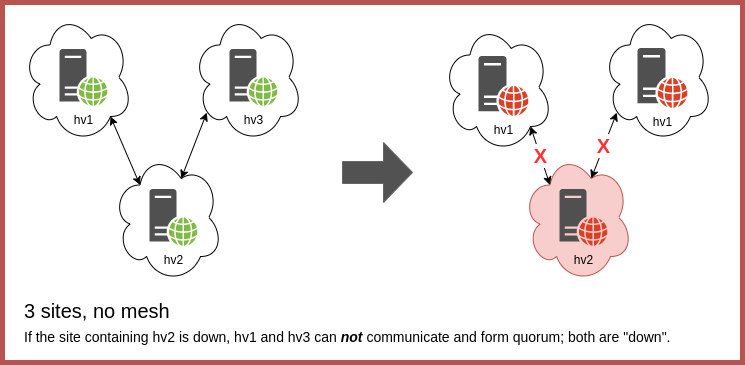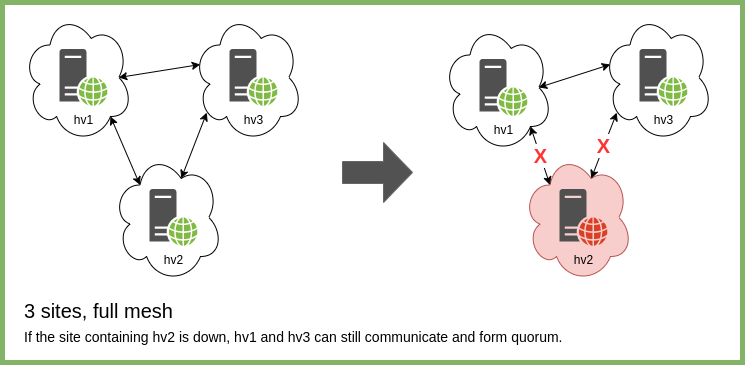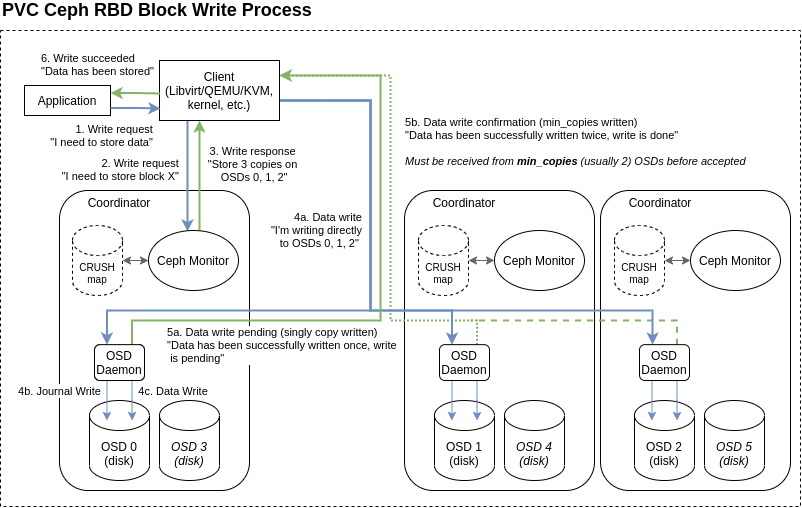A PVC cluster can have nodes in different physical locations to provide georedundancy, that is, the ability for a cluster to suffer the loss of a physical location (and all included servers). This solution, however, has some notable caveats that must be closely considered before deploying to avoid poor performance and potential fencing failures.
This page will outline the important caveats and potential solutions if possible.
Node Placement & Physical Design¶
In order to form a proper quorum, a majority of nodes must be able to communicate for the cluster to function.
2 site georedundancy is functionally worthless with a PVC cluster. Assuming 2 nodes at a "primary" site and 1 node at a "secondary" site, while the cluster could tolerate the loss of the secondary site and its single node, said single node would not be able to take over for both nodes should the primary site be down. In such a situation, the single node could not form a quorum with itself and the cluster would be inoperable. If the issue is a network cut, this would potentially be more impactful than allowing all nodes in the cut site to continue to function.
In addition, a 3 site configuration configuration without a full mesh or ring, i.e. where a single site which functions as an anchor between the other two, would be a point of failure and would render the cluster non-functional if offline.
Thus, the smallest useful, georedundant, physical design is 3 sites in full mesh or ring. The loss of any one site in this scenario will still allow the remain nodes to form quorum and function.
A larger cluster could theoretically span more sites, however with a maximum of 5 coordinators recommended, this many sites is likely to be overkill for the PVC solution.
Hypervisors¶
Since hypervisors are not affected by nor affect the quorum, any number can be placed at any site. Only compute resources would thus be affected should that site go offline.
Fencing¶
PVC's fencing mechanism relies entirely on network access. First, network access is required for a node to update its keepalives to the other nodes via Zookeeper. Second, IPMI out-of-band connectivity is required for the remaining nodes to fence a dead node.
Georedundancy introduces significant complications to this process. First, it makes network cuts more likely, as the cut can occur outside of a single physical location. Second, the nature of the cut means, that without backup connectivity for the IPMI functionality, any fencing attempt would fail, thus preventing automatic recovery of VMs on the cut site.
Thus, in this design, several normally-possible recovery situations become harder. This does not preclude georedundancy in the author's opinion, but is something that must be more carefully considered, especially in network design.
Network Speed¶
PVC clusters are quite network-intensive, as outlined in the hardware requirements documentation. This can pose problems with multi-site clusters with slower interconnects. At least 10Gbps is recommended between nodes, and this includes nodes in different physical locations. In addition, the traffic here is bursty and dependent on VM workloads, both in terms of storage and VM migration. Thus, the site interconnects must account for the speed required of a PVC cluster in addition to any other traffic.
Network Latency & Distance¶
The storage write process for PVC is heavily dependent on network latency. To explain why, one must understand the process behind writes within the Ceph storage subsystem:
As illustrated in this diagram, a write will only be accepted by the client once it has been successfully written to at least min_copies OSDs, as defined by the pool replication level (usually 2). Thus, the latency of network communications between the client and another node becomes a major factor in storage performance for writes, as the write cannot complete without at least 4x this latency (send, ack, receive, ack). Significant physical distances and thus latencies (more than about 3ms) begin to introduce performance degradation, and latencies above about 5-10ms can result in a significant drop in write performance.
To combat this, georedundant nodes should be as close as possible, both geographically and physically.
Suggested Scenarios¶
The author cannot cover every possible option, but georedundancy must be very carefully considered. Ultimately, PVC is designed to ease several very common failure modes (maintenance outages, hardware failures, etc.); while rarer ones (fire, flood, meteor strike, etc.) might be possible to mitigate as well, these are not primary considerations in the design of PVC. It is thus up to each cluster administrator to define the correct balance between failure modes, risk, liability, and mitigations (e.g. remote backups) to best account for their particular needs.



